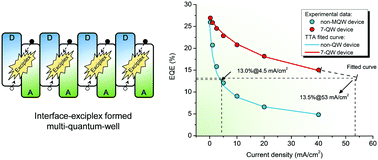Management of excitons for highly efficient organic light-emitting diodes with reduced triplet exciton quenching: synergistic effects of exciplex and quantum well structure†
Abstract
Non-doped architecture has achieved great success as a universal method for simplifying the structure of organic light-emitting diodes (OLEDs). Currently, great challenges remain in the quest to further enhance the efficiency and reduce the pronounced roll-off for ultrathin emitting layer (UEML) based devices. This paper proposes a new strategy by synergistically incorporating the so-called “interface-exciplex” (i-Exc) with a multi-quantum-well structure (MQW). In our green-emitting OLEDs, an extremely low voltage of ∼2.8 V at a current density (j) of 0.2 mA cm−2 is achieved, allowing the attainment of a maximum power efficiency (PE) of 92.8 lm W−1 with an external quantum efficiency (EQE) of 26.9%. More impressively, the population of triplet excitons is substantially reduced with the EQE just dropping by ∼5% from its maximum at a luminance (L) of 1000 cd m−2 for our 7-QW device. This compares favorably with a structurally similar device without the MQW whose EQE dropped as much as ∼31%. The nearly 6-fold enhancement in efficiency roll-off suggests that our findings could be a significant step towards realizing non-doped and low-cost OLED applications with outstanding performance at high luminances.



 Please wait while we load your content...
Please wait while we load your content...